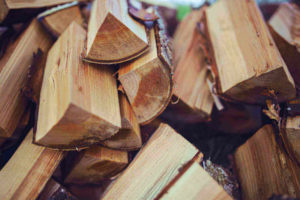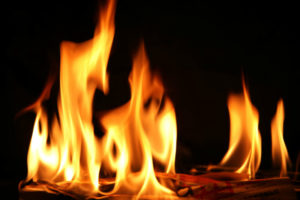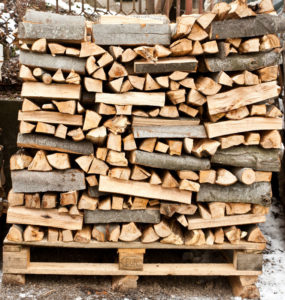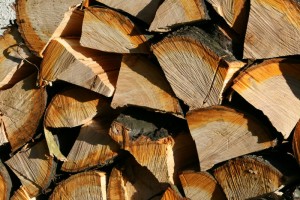Fall is here, and winter is right around the corner! As you prepare your fireplace for the burning season ahead, it is important to ensure you have the best firewood for your heating appliance. Many homeowners are surprised to learn that the firewood they use affect the safety and efficiency of their fireplaces. You have to purchase the right kind of firewood and store it correctly, these factors will improve your burning experience.
Types of firewood
 Firewood are divided into two main categories: hard woods and soft woods. Hard woods are dense, heavy. They come from trees who’s leaves change color each season. Ash, birch, maple, and oak are a few of the most popular hard woods. Hard woods make excellent firewood because they create fires that burns hotter while creating less smoke.
Firewood are divided into two main categories: hard woods and soft woods. Hard woods are dense, heavy. They come from trees who’s leaves change color each season. Ash, birch, maple, and oak are a few of the most popular hard woods. Hard woods make excellent firewood because they create fires that burns hotter while creating less smoke.
Soft woods come from evergreen trees with needles such as firs and pines. They tend to ignite quickly. This makes them ideal for kindling. However, they are known for creating large amounts of fragrant smoke, even when seasoned. This makes them ideal for outdoor firepits or when smoking meats.
Choosing the right firewood
The kind of firewood you choose often comes down to personal preference. No matter what kind of firewood you choose, it is important that the wood has been properly seasoned. Seasoned wood is wood that has been cut, stacked, and stored for at least six months to reduce the moisture content in it.
Seasoned firewood has significantly less moisture in it then freshly cut wood. Lowering the moisture content allows the firewood to ignite faster, burn hotter, and produce less smoke. Jack Pixley Chimney Sweeps and Masonry sells moisture meters. This tool shows the moisture content in seasoned firewood. Wood should have less than 20% moisture content to be burned indoors.
Drying wood in four easy steps
The EPA suggests four easy steps to correctly and easily dry your firewood.
- You must split the wood. Start by splitting large logs into uniform pieces. Having smaller logs in even sizes helps the wood dry faster.
- You need to stack them. Stack wood split side down on a dedicated firewood rack. Keep wood off the ground and away from buildings, this allows air to circulate through the wood pile and dry faster without rotting.
- You need to cover them. While the sides of the stack should remain open, cover the top of the firewood stack. This keeps moisture from rain and snow from seeping down to the stack.
- Then you need to store them properly. You need to give wood enough time to dry. Soft woods take around 6 months to dry when cut and stacked. Hard woods take upwards of 12 months before they are completely seasoned.
The kind of firewood you pick for your fireplace can really impact the efficiency and performance of your fire. This winter, make sure to burn wood that has been seasoned. For more information about seasoning firewood or purchasing a Moisture Meter, contact Jack Pixley Sweeps today!
While there are few truly wrong ways to light a fire, there are a number of fire starting techniques that can make lighting a fireplace fire easier and more efficient. Follow these five easy steps to help learn how to light your best ever fires in your fireplace this winter.
Step One
Have your fireplace swept and inspected each year. Whether you use your fireplace every day or only a few times per year, every chimney needs to be swept and inspected annually. This prevents buildup and blockages in the flue, as well as helps spot damage or deterioration before it causes major fireplace performance problems.
Step 2
Use the right firewood. The kind of firewood you use in your fires can have a major impact on fireplace performance. Firewood should be cut, stacked, and seasoned for at least a year to remove moisture content from the wood, helping it burn hotter and produce less smoke and creosote. Hardwoods such as ash, beech, cedar, maple, and oak burn hotter, more efficiently, and with less smoke; softwoods such as firs, pines, and spruces should be avoided in indoor fires. Likewise, woods from fruit trees such as cherry, apple, or plum are known for their pleasant aroma and can be used to create a pleasant smelling fire.
Step 3
Warm the flue. Before lighting even the kindling, make sure the damper is completely open. Opening the damper prevents smoke and gas from blowing back into your home. After opening the damper, there may be a rush of cold air for a few moments; if this downward draft of cold air continues for more than a few minutes, try warming the flue. Light rolled up newspaper and hold it directly below the damper. Doing this creates enough warm air to stop downdrafts without creating large amounts of smoke that can be blown back into your home.
Step 4
Start with kindling before adding wood. At the bottom of the grate, place rolled up lint, newspaper, or other fire starting aids between two large pieces of kindling wood. Create a second row of kindling lengthwise over the first stacked at a 90 degree angle; continue this until you have 3-4 rows of alternately-stacked kindling. Light the kindling from the newspaper at the bottom.
Step 5
Add logs after the kindling has ignited. Once the kindling is well-lit, begin adding firewood logs. Begin by placing 2 smaller, split logs onto the kindling; after 10 minutes, continue adding additional logs. Most smaller logs take between 5-15 minutes to burn; larger logs can burn for longer amounts of time, but also take longer to ignite. Try to add your next logs while the fire is still actively burning as adding wood on top of glowing charcoals or embers can be extremely difficult to ignite.
Contact Jack Pixley Sweeps
Following these steps to light your next fireplace fire can help ensure you have a fire that burns safer, more efficiently, longer, and with less smoke. For more information on the best way to start a fire in your fireplace, contact the chimney experts at Jack Pixley Sweeps today!
While it’s warm and sunny now, cooler weather will be here before we know it. Summer is the perfect time to start thinking about firewood for the fall.
What is a cord of firewood?
When sold in large quantities, wood is typically sold by the cord. However, many people are unfamiliar with how large – or small – a cord of wood is. Unfortunately, many wood dealers capitalize on this confusion by cutting corners and underselling on cords of wood. The following measurements of the different cords of wood can help buyers ensure they are getting the correct amount of wood in their cord.
- Standard cord: Also known as a full or bush cord. 4’H X 8’L X 4’ Deep, 128 cubic feet
- Face cord: Also known as a rick or short cord. 4’H X 8’L X 1’-2’ Deep
- Long cord: 4’H X 8’L with a depth greater than 4’
- Unit: 1/24th of a standard cord; can fit in the trunk of most cars. 2’H X 2’L X 16” Deep
When buying wood, especially in quantities of a cord or larger, it is important to ensure you are getting wood that has been seasoned. Seasoned wood has been cut, stacked, and stored for at least six months or longer to reduce the moisture content in the wood.
Additional tips for buying firewood
The following tips can help ensure you are getting the best possible firewood.
- Find a reputable dealer. There are a number of places to find firewood; hardware stores, fireplace dealers, tree trimmers, and independent sellers are just a number of places to find firewood. A reputable seller should be able to answer questions about the wood, such as when it was cut, what type of trees it came from, and how long it has been seasoned.
- Pick the right wood. While the type of wood you use often comes down to personal preference, not all woods were created equally. Hard woods such as ash, maple, and oak burn at hotter temperatures and with less smoke, making them ideal for indoor fires.
- Store your firewood correctly. After spending – and money!- finding the right firewood, don’t ruin your investment by storing it incorrectly. Wood should be stored off the ground in a neat stack; while the top should be covered to prevent moisture from seeping into the wood pile, leave the sides open for ventilation.
Finding and buying the right amount of firewood can ensure you and your family enjoy cost effective fires all season long. For more information on firewood cords, contact Jack Pixley Sweeps today.
 Getting the most out of your fireplace takes more than just throwing wood and some kindling into the firebox. Starting a fire the wrong way can lead to sluggish fires that do not burn well, burn out quickly, or need to be stoked or have wood added constantly. By taking the time to correctly build a fire, you can spend less time stoking and more time enjoying it with family and friends. The following easy-to-follow tips can help you build a better fire the next time you use your fireplace!
Getting the most out of your fireplace takes more than just throwing wood and some kindling into the firebox. Starting a fire the wrong way can lead to sluggish fires that do not burn well, burn out quickly, or need to be stoked or have wood added constantly. By taking the time to correctly build a fire, you can spend less time stoking and more time enjoying it with family and friends. The following easy-to-follow tips can help you build a better fire the next time you use your fireplace!
Start a top down fire
How you stack your logs has a big impact on the quality of your fire. Top down fires minimize the need for stoking by making sure the wood gets enough oxygen as it burns. Build a top down fire by putting the largest logs on the bottom of the grate, ends facing the front and back of the firebox. Continue pyramid stacking progressively smaller and smaller logs, intertwining the stack with kindling. Ignite the top log and kindling; as the wood burns down it will naturally ignite the logs underneath it, reducing the need to add to or stoke the fire.
Warm your flue
If the weather outside is significantly colder than the temperature inside your home, warming the flue before starting a fire can reduce smoke blow-back and drafting problems. Open the damper before creating a kindling bundle of newspaper; ignite the newspaper and hold it under the open damper for several minutes – or until it burns up – to gradually warm the air temperature in the flue.
Use the right firewood
The type of firewood you use can have a major impact on the quality of your fire. For best results, seasoned hard woods should be used. Seasoned wood is made when logs are cut, stacked, and allowed to naturally dry by exposure to the elements; this reduces the moisture content in the wood and helps fires burn hotter, longer, produce less smoke, and create less creosote.
If you want to create a more aromatic fire, seasoned soft woods like cherry, pine, or fir can be used. However, soft woods often burn at a lower heat and create more smoke, making them better tailored to outdoor fire pits than indoor fireplaces. Using citrus peels as a natural kindling is an easy alternative that can add additional fragrance to your fires.
Have your chimney swept
Chimneys should be swept and inspected annually. Doing this ensures that the fireplace and flue are clean, undamaged, and safe to use. Chimney inspections can also help spot areas of damage or deterioration in the chimney and flue that may not be easily recognized by homeowners. Certified chimney sweeps can also help diagnose and repair fireplace performance problems such as drafts, odors, or leaks.
Get the most out of your fireplace this winter by following our easy burning tips. For more information on starting a good fire or to schedule your next chimney sweeping, contact Jack Pixley Sweeps today!
Relaxing in front of a fire with friends and family is supposed to be an enjoyable way to unwind. Unfortunately, fireplace smoking and draft issues can make it impossible to enjoy a fire.
There is not one sole cause for fireplace smoking issues; there are a numbers of reasons why your fireplace may be smoking or not drafting correctly. Because of this, it is important to work with a CSIA certified chimney technician in order to identify the underlying cause of the smoking.
What is causing my smoking fireplace?
If burning a fire in your fireplace sends smoke back into your living room instead of up the chimney, you have a smoking problem. Unfortunately, finding the cause of a smoking fireplace may not be easy; there are as many as 15 different causing for smoking fireplaces and drafting issues. The following are some of the most common causes of smoking fireplaces.
- Flue blockages: One of the easiest to identify – and easiest to repair – causes of a smoking fireplace is a flue blockage. If the flue is partially or completely blocked, the chimney cannot correctly draft smoke from the fire up the chimney; this causes the smoke to blow back or settle in the room. Flue blockages are most commonly caused by debris such as sticks and leaves or from animal nesting materials. A working, well fitted chimney cap along with annual chimney inspections are the best ways to keep flue blockages from occurring.
- Using the wrong firewood: The kind of firewood you use can have an impact on how much smoke your fire produces. All firewood should be seasoned, or allowed to dry by exposure to the elements, for at least six months before burning. Doing this reduces the moisture content in the wood – and reduces how much smoke the logs produce. Likewise, choosing hardwoods such as ash, birch, or oak will produce less smoke than softwoods such as pines, firs, and spruces.
- Incorrectly sized flue: The size of the flue should correspond to the size and type of fireplace in order to draft effectively. A flue that is too large or too small can create smoking issues. This is often seen in homes where a new fireplace insert has been installed into an existing firebox; if the flue is too large, too much air will be pulled down into the chimney and smoke can be pushed back into the room. Likewise, a flue that is too small will not be able to draw smoke up into the chimney fast enough.
Negative air pressure: The height of your chimney can affect the air pressure around your home. Standard building codes require that chimneys must be at least two feet taller than any structures within a 10 foot radius. Nearby building, tall trees, overhanging branches, and second story home additions can all change the air pressure surrounding your chimney and lead to drafting problems.
Don’t let a smoking fireplace keep you from enjoying fires this fall and winter. Contact Jack Pixley Sweeps today to schedule an appointment and begin troubleshooting the cause of your smoking fireplace.

Proper storage of firewood can lead to better fires
While most homeowners go to great lengths to ensure that their fireplaces are properly maintained and in excellent working condition, many do not put nearly as much thought into what they’re putting into their fireplaces each season. Using the correct type of firewood – as well as wood that has been correctly seasoned and stored – can greatly improve fireplace performance and ensure that your fireplace system works well for years to come.
Firewood types
Although firewood is a generic term, each wood species has its own unique set of burning characteristics. Different species burn at different temperatures, speeds, and create varying amounts of smoke. Because of this, it is important to do research before investing in a large amount of firewood for the fall and winter.
The most popular and commonly used woods are often hardwoods. Hardwoods include species such as ash, maple, and oak, and can be identified by their broad leaves that typically change color during the fall. Hardwoods are generally preferred because they burn hotter and more steadily, producing less smoke than softwoods. However, hardwoods often light slowly, which can be a source of frustration when trying to build a warm, roaring fire.
Softwoods are typically needle-leafed trees such as firs, pines, and spruces. Because they produce more smoke when burned, softwoods are often a popular fuel for smoking meats. While their low burning temperature makes them somewhat less popular for fires, their ability to ignite quickly makes softwoods an ideal source for kindling. A prime example of this is using softwood kindling for a fire with hardwood logs.
Firewood seasoning
No matter what species of type of wood is being used, it is vitally important that the wood has been properly seasoned. Seasoned firewood is wood that has been chopped, stored, and exposed to the sun for at least 6 to 12 months. Doing this removes the moisture from the wood, allowing it to burn more efficiently and with less smoke. Wood that has not been properly seasoned will typically be hard to ignite and hiss while being burned due to the high water content in the wood.
Firewood that has been suitably seasoned will be lighter and less dense than freshly-cut wood, and banging two dried pieces together should produce a hollow, rather than dull, sound. Likewise, seasoned wood will often have cracked or split ends, indicating that the majority of the moisture has left the wood.
Firewood storage
While firewood should be exposed to sun and wind during the summer for seasoning, it needs to be protected from rain and snow during the winter. A cover, roof, or tarp can be used to protect a firewood pile and prevent snow from building up on the stack; however, whenever possible, the sides should remain open to allow air flow in the wood. This allows the seasoning process to continue and prevents a buildup of moisture. Likewise, wood should be stored off the ground to keep the bottom layer of wood dry, prevent rotting, and avoid insect infestation.
When bringing wood inside for use, only carry as much as you will immediately need. Firewood that is stored for long periods of time at room temperature can cause any dormant bugs in the wood to be become active.
 Firewood are divided into two main categories: hard woods and soft woods. Hard woods are dense, heavy. They come from trees who’s leaves change color each season. Ash, birch, maple, and oak are a few of the most popular hard woods. Hard woods make excellent firewood because they create fires that burns hotter while creating less smoke.
Firewood are divided into two main categories: hard woods and soft woods. Hard woods are dense, heavy. They come from trees who’s leaves change color each season. Ash, birch, maple, and oak are a few of the most popular hard woods. Hard woods make excellent firewood because they create fires that burns hotter while creating less smoke.
 Getting the most out of your fireplace takes more than just throwing wood and some kindling into the firebox. Starting a fire the wrong way can lead to sluggish fires that do not burn well, burn out quickly, or need to be stoked or have wood added constantly. By taking the time to correctly build a fire, you can spend less time stoking and more time enjoying it with family and friends. The following easy-to-follow tips can help you build a better fire the next time you use your fireplace!
Getting the most out of your fireplace takes more than just throwing wood and some kindling into the firebox. Starting a fire the wrong way can lead to sluggish fires that do not burn well, burn out quickly, or need to be stoked or have wood added constantly. By taking the time to correctly build a fire, you can spend less time stoking and more time enjoying it with family and friends. The following easy-to-follow tips can help you build a better fire the next time you use your fireplace!
